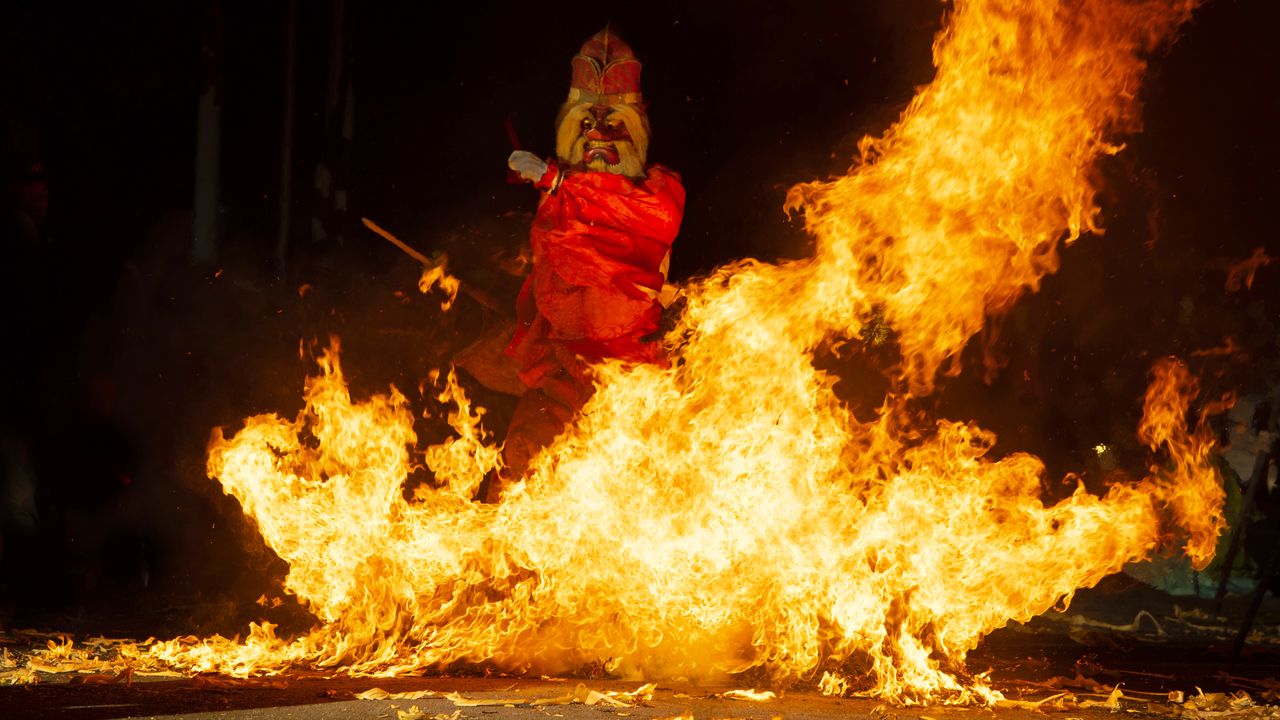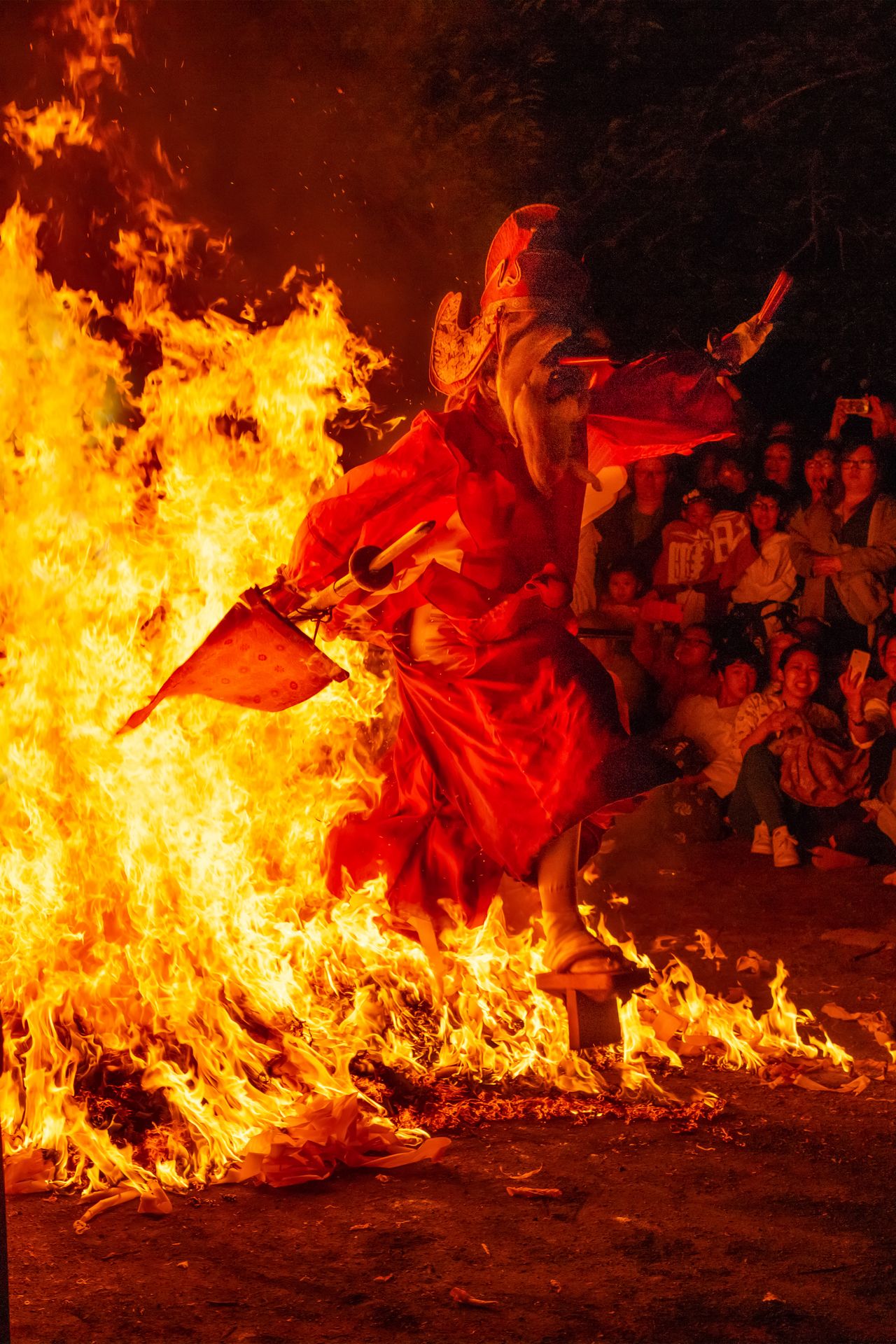
Purification and Prayer: Japan’s Fire Festivals
Guideto Japan
Culture- English
- 日本語
- 简体字
- 繁體字
- Français
- Español
- العربية
- Русский
Fire-Based Rituals
Dewa Sanzan, “the three mountains of Dewa,” refers to Mount Haguro, Mount Gassan, and Mount Yudono, which have long been sacred sites for mountain worship. An autumn initiation ritual for novice yamabushi mountain ascetics has taken place every year since Dewa Sanzan first opened as a religious center over 1,400 years ago. I have also participated in the ritual, receiving the yamabushi name Yōkō.
The ritual, a seven-day pilgrimage, began with the leader explaining that human beings become impure simply by existing. They fall into hell, gradually becoming human as they are purified, and grow closer to the kami spirits and deities. During ascetic practice trudging through the mountains, the novices intone yamabushi incantations , their sins washed away and their spirit purified by standing under a miracle-working waterfall. The pilgrimage ended with a ceremony of a ritual fire burning tablets inscribed with prayers. After undergoing trials by water and by fire, participants are allowed to ask the deities for favors.
Those who encountered something sacred in their nature through the ritual felt the need for purification. Fire-based rituals also burn away evil spirits and purify as the devout fervently pray for happiness. I have been especially moved by the three fire festivals I describe below.
Nachi no Ōgi Matsuri (Annual Festival of Kumano Nachi Taisha)
(July 14, Nachi Katsuura, Wakayama Prefecture)

Parishioners carry torches to purify the 133 stone steps to the shrine. (© Haga Library)
The Nachi Waterfall, long a sacred site for yamabushi, drops 133 meters down into the basin below. Looking up at the majestic falls brings a sense of religious awe. The basin, called Otakimoto, is where 12 kami spirits are said to have alighted in ancient times. In 317, the Kumano Nachi Taisha shrine, halfway up Mount Nachi, was built to worship them, and the smaller Hirō Jinja shrine, which venerates the waterfall itself, was erected at its base.
Once a year, the Nachi no Ōgi Matsuri sees the 12 kami return to Hirō Shrine. In the ohi ritual that begins at two in the afternoon, the kami are transferred to mikoshi portable shrines modeled after the falls and slowly carried down the stone steps to the waterfall.

The 12 mikoshi, thin red boards six meters tall representing the falls, are gathered at the waterfall basin. (© Haga Library)
After the shrine approach has been purified with water from the falls, 12 huge torches are lit and used to drive out evil spirits with their flames. At the head of the mikoshi procession, men twirl the roaring torches. The shrine approach is dim even in daytime, so it makes for a compelling spectacle when it is illuminated by the torches’ bright light.

After a shrine priest taps the 12 mikoshi with a folding fan, they are carried to the base of the waterfall. (© Haga Library)
When the white-clad parishioners reach the waterfall basin, they hold fans while performing dances to pray for bountiful harvests and singing the praises of the falls. Spectators watching the ritual must also feel purified and uplifted.

The flaming torches, fashioned from hinoki Japanese cypress and each weighing 50 kilograms, are an impressive sight. The event is also known as the Nachi Fire Festival. (© Haga Library)
Oniyo
(January 7, Kurume, Fukuoka Prefecture)

Constructed from bamboo and sugi Japanese cedar leaves, the huge torches, 1 meter across and 13 meters long, each weigh 1.2 tons. (© Haga Library)
Oniyo originated when the kami Tamatare drove out bandits who had been terrorizing the local populace. Its name means “the night of the oni,” supernatural creatures roughly equivalent to demons. According to legend, in 368, Tamatare lit a torch to seek a bandit hiding in the dark, and cut off his head and burned him. For over 1,600 years, the event has been reenacted yearly on January 7 as the festival of Daizenji Tamataregū Shrine in a ritual to ward off disaster and pray for a year of happiness The festival is also called Tsuina or Oniharai, a reference to driving out demons lurking in the night.

Loincloth-clad youths emit spirited cries as they wade into the frigid river. (© Haga Library)
At eight at night, the event leader heads a procession of parishioners carrying two giant torches down to the river in front of the shrine. In the purification pool set up for the occasion, the leader engages in ablutions, followed by a crowd of youths who do the same and then sprint up to the shrine.
At nine, the opening gong sounds and all the lights are turned off. Using the onibi demon fire struck on the last day of the old year, the shrine priest lights six giant torches. Hundreds of youths mill about, chanting oisa, oisa as they prop up the flaming torches with sturdy oak staves. They parade around the shrine precincts in a shower of sparks, the churning procession like a whirlpool of fire. As the festival reaches its climax, oni, moving under the cover of darkness, purify themselves in the ritual pool and return to the shrine. All the torches are extinguished, and the festival comes to an end.

These giant torches were lit by a small sacred fire. Being showered with falling sparks and embers is said to ensure good health in the coming year. (© Haga Library)
Tengu no Hiwatari (Annual Festival of Bikuni Jinja)
(July 4–6, Shakotan, Hokkaidō)

The tengu leaps out of the fire into the external world. After seeing this action on social media, I traveled to Shakotan to take photos myself. (© Haga Library)
On the day of the annual festival of Bikuni Shrine in July, Sarutahiko, the deity of mountain opening, appears. With a long nose and red face, he is revered as Tengu-sama, who drives out evil spirits and promises fishers safety at sea and abundant catches.
Tengu and the mikoshi visit all the neighborhoods, and residents are expected to behave respectfully. Should someone observe the procession from high up or leave laundry out to dry, Tengu will wordlessly point his fan at the offending sight to signal this breach of etiquette. Tengu’s attendants then scramble to purify the site with salt.

The geta worn by Tengu are 20 centimeters high and have only a single “tooth.” (© Haga Library)
At dusk, the site of the fire-walking ritual on July 5 and 6 is prepared as huge piles of wood shavings are placed in the shrine precincts. Tengu and the mikoshi will walk through the fire to rid the town of impurity and evil spirits. Although the ritual’s origin is not clear, it may have come from the shugendō practice of fire-walking.
More wood shavings are piled onto the fires as the tengu circles them. As the flames leap higher and higher, Tengu crosses them all at once, repeating the walk three times. The dancing flames make it difficult to capture the sight properly in photos. The mikoshi follows, also doing three passes, and is returned to the shrine after purification.
A successfully concluded Shakotan fire festival is said to ensure a rich local sea urchin harvest. Visitors can look forward to treating themselves to a succulent meal of unidon, a rice bowl topped with fresh sea urchin, at a price far more reasonable than in the big cities.

In the finale, the mikoshi proceeds through the fire. (© Haga Library)
(Originally published in Japanese. Dates given are those on which the festivals are usually held. Banner photo: A scene from Tengu no Hiwatari Annual Festival of Bikuni Jinja in Hokkaidō. © Haga Library.)
